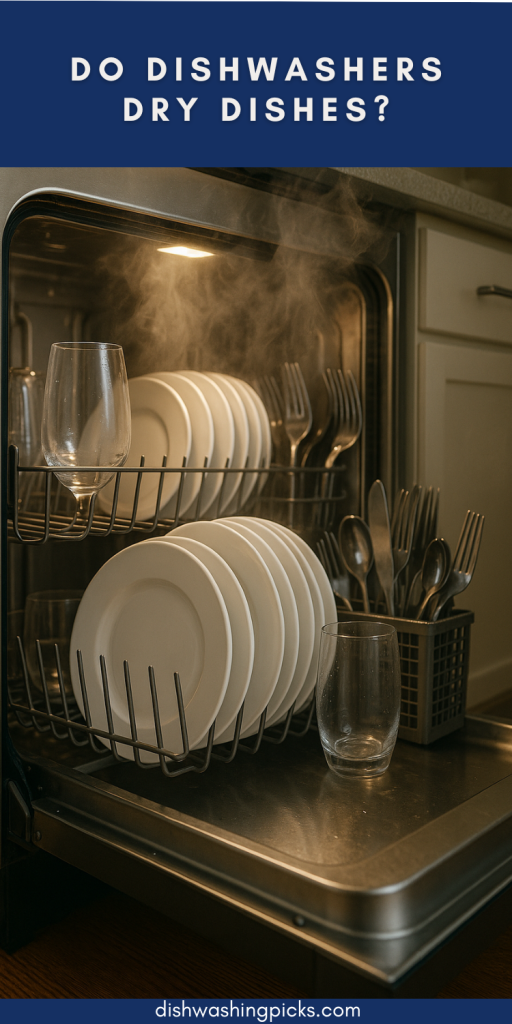
That Weirdly Wet Mug
So, you open your dishwasher after the cycle ends. It’s beeped. The light says “Clean.” You’re ready to unload and move on with your day. But then… you reach for a cup—and it’s still damp. 🙄
What gives?
Aren’t dishwashers supposed to wash and dry your dishes?
Well… yes. But how well they dry depends on a few things most people never think about. Let’s unpack what’s really going on behind that steamy door and what you can do to finally stop towel-drying your Tupperware.
Yes, Dishwashers Do Dry—But Not Always Equally
Dishwashers are designed to dry dishes. That’s part of the job description. But here’s the thing:
Not all dishwashers dry the same way.
Some use a heating element. Others rely on condensation. Some need you to push an extra button. Others just hope for the best.
Let’s break down the three main methods dishwashers use:
1. Heated Drying (Old-School Style)
This is where an actual heating element (usually on the bottom) gets hot enough to evaporate water after the final rinse.
- Pros: Works well, especially on ceramic or metal
- Cons: Uses more energy; can melt plastic; not as common in new eco-friendly models
2. Condensation Drying (Eco-Friendly Style)
Here, the dishwasher uses the heat from the final rinse + cool stainless steel walls to cause water to “condense” off the dishes and drip away.
- Pros: Saves energy; no heating coil
- Cons: Slower; doesn’t work great on plastic or tightly packed dishes
3. Fan-Assisted Drying (Premium Style)
Some high-end models use a built-in fan to circulate hot air and speed up drying time.
- Pros: Fast and efficient
- Cons: Adds cost; not standard on all models
👉 So, yes—they dry. But not always perfectly.
Why Are My Dishes Still Wet, Then?
If your dishwasher says it’s done, but your dishes say otherwise, here are the likely culprits:
1. You’re not using rinse aid
Yep—this tiny liquid makes a huge difference. It helps water sheet off instead of clinging to surfaces.
Imagine your dishes in a little waterproof jacket. That’s basically what rinse aid does.
2. You’re washing too many plastic items
Plastic doesn’t retain heat like glass or ceramic, so it cools down faster. That makes water stick to it instead of evaporating.
Ever notice it’s always your plastic cups and storage containers that are still wet? Now you know why.
3. The drying cycle is off (literally)
Many dishwashers let you turn drying off to save energy. Double-check your settings—you might be skipping it without realizing.
4. Your dishwasher’s door is staying sealed
If you leave the door shut after the cycle ends, steam stays trapped inside. Just cracking it open can make a big difference.
5. Your dishwasher’s insulation or heating element isn’t working right
If nothing ever feels warm post-cycle, it may be a part failure. Time to call in a pro or check the manual.
Tips to Get Drier Dishes—Without the Towel
Want to stop hand-drying dishes? Try these quick tricks:
Always use rinse aid (yes, even if you use pods—it still matters)
Crack the door open after the cycle ends to let steam escape
Choose the “Heated Dry” or “Extra Dry” setting if your machine has it
Unload the bottom rack first so water from the top doesn’t drip down
Avoid overloading—air needs space to circulate
Angle bowls and cups downward so water doesn’t pool
Try thinking of it like packing a suitcase: if everything’s crammed in tight, nothing airs out.
Are There Dishwashers That Actually Nail the Drying Game?
Totally! If you’re shopping around and drying is your #1 pain point, look for features like:
- Auto-open doors (they pop open after a cycle to release steam—genius)
- Zeolite drying (yep, real volcanic minerals that absorb moisture—hello, Bosch)
- Fan-assisted drying (think brands like Miele or higher-end KitchenAid)
These models are usually more expensive, but they will leave your dishes bone-dry.
The Answer Isn’t Just “Yes or No”—It’s “It Depends”
So… do dishwashers dry dishes?
Yes, they absolutely try.
But how well they succeed? That depends on your machine, your settings, what you’re washing, and—yep—even whether you opened the door afterward.
If you want to stop playing “towel patrol” every time you unload, a few tiny tweaks can seriously change the game.
